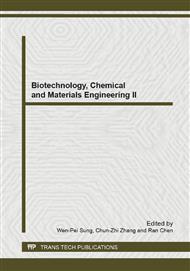[1]
HAN Jun, HOU Jun, XUE Zong-hao, et al . Research of the limits of development indexes of Putaohua oilfield in high water cut period[J]. Journal of Xi'an Shiyou University (Natural Science Edit ion), 2004,19(1): 44-48.
Google Scholar
[2]
LIU Hong–tao. Reservoir parameter interpreting method of Putaohua oilfield[J]. Petroleum Geology &Oilfield Development in Daqing, 2004, 23(1): 67-69.
Google Scholar
[3]
CAO Guang-sheng , WU Jun-hai , DONG Jing-wu, et al. Petrographical Characteristics and Sensitivities of Reservoir Cores of Peripheral Oil Fields in Daqing[J]. Oilfield Chemistry, 2002, 19(2) : 105-107.
Google Scholar
[4]
WU Xiao-lin; CHEN Jian; LUN Shi-yi. Application of biosurfactant in enhanced oil recovery[J]. Joural of Biology, 2000, (06):25-28.
Google Scholar
[5]
LU Shou-liang, TIAN Yan-chun, YU Bai-lin, et al. Study on Decreasing the Volume of the chemical Agent of ASP Flooding [J]. Petroleum Geology & Oilfield Development In Daqing, 2001, (06):43-45.
Google Scholar
[6]
LI Hua-bin, YANG Zheng-yu, YANG Lin, et al. Investigation on Rhamnolipid Biosurfactant Used in Enhanced Oil Recovery of Daqing Oilfield [J]. Journal of Southwest Petroleum University(Science & Technology Edition), 2001, 23 (1) : 25-29.
Google Scholar
[7]
HUANG Mei. Rhamnoilpid Bio-surfactant Composite Flooding Test Resuts and Understanding [J]. Petroleum Geology & Oilfield Development In Daqing, 2006, (S1):81-82.
Google Scholar
[8]
ZHAO Li, SUN Yang, JIN Yan-fang, et al. Oil Replacement by the Combination of Enzyme and Rhamnolipid Fermentation Liquor[J]. Journal of Southwest Petroleum University(Science & Technology Edition) , 2008,30(1): 119-121.
Google Scholar
[9]
CHENG Jie-cheng, LIAO Guang-zhi, YANG Zhen-yu, et al. Pilot Test of ASP Flooding in Daqing Oilfield [J]. Petroleum Geology & Oilfield Development In Daqing, 2001 , 20 (2) : 46-49.
DOI: 10.1515/energyo.s13202-013-0061-2
Google Scholar
[10]
ZHANG Zi-han, YANG Zhen-yu, GUO Zhi , et al. Feasibility of the ASP flooding in Northern Putaohua oilfield in Daqing [J]. Petroleum Geology & Oilfield Development In Daqing, 2005, 24(1): 82-84.
DOI: 10.1515/energyo.s13202-013-0061-2
Google Scholar
[11]
CHEN Zhong-hua, LI Hua-bin, CAO Bao-ge, et al. Study on the Relation between Level of IFT and Enhanced Oil Recovery [J]. offshore Oil, , 2005, (03) : 53-57.
Google Scholar
[12]
TANG Gang, LI Hua-bin, SU Min. Study on relation between interfacial tension and displacement efficiency of ASP flooding[ J]. Petroleum Geology & Oilfield Development In Daqing, 2005, (03):81-83.
Google Scholar
[13]
GUO Zhi, WU Li-jun, MEI Qi-tai et al. Feasibiality of the Polymer Flooding in Northern Putiaohua Oilfield[J]. Petroleum Geology & Oilfield Development In Daqing, 2001, 20(2): 80-82.
Google Scholar
[14]
XU Hong-dong, LIU Hong-yuan, WU Li-jun, et al. The Feasibility Study on the Depth Profile Control with the Cross-linked Polymer in the Narrow Sand Body Oilfield [J]. Petroleum Geology & Oilfield Deuelopment In Daqing, 2002, 21(6): 55-7.
Google Scholar
[15]
GAI Li-xue, WANG Yan-ling, BAI Lu-lu et al. Application of MEOR Technology in the Low Permeability Reservoirs of Daqing Oilfield [J]. Petroleum Geology & Oilfield Development in Daqing, 2011, 30(2): 145-149.
Google Scholar


